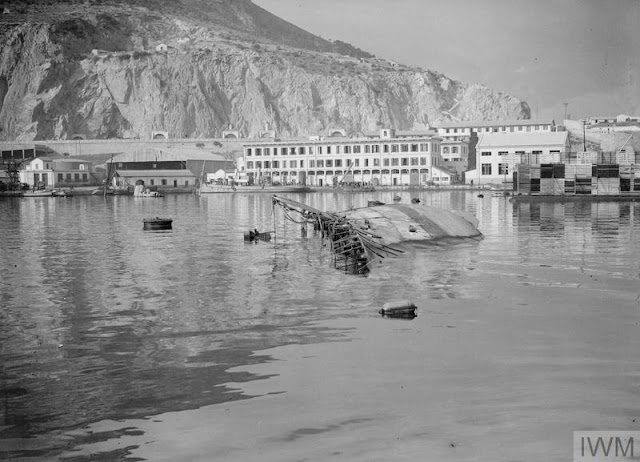"Nazi Officials Captured in North Africa En Route to U.S."
News is Wrapping Up Related to Operation Torch
News Clippings November 28 - December 2, 1942
CNA646. Heading - ROYAL AIR FORCE OPERATIONS IN THE MIDDLE EAST
AND NORTH AFRICA, 1939-1943. Caption - German Type VIIB submarine, U-83,
under attack in the Mediterranean, 80 miles North-east of Oran, Algeria, from a Lock-
heed Hudson of No. 500 Squadron RAF based at Blida. Three 100-lb AS bombs are
seen exploding short of the target after the first attack run. The Hudson then dropped
three 150-lb depth charges on the U-83 from 75 feet and the submarine sank.
Photo Credit - No. 500 Squadron RAF, Imperial War Museum (IWM)
Introduction:
Good articles that mention the names of individual members of RCNVR and Combined Operations fulfilling their duties during Operation Torch are as rare as hens' teeth, so, the overall rarity and importance of the last entry (Part 10) cannot be understated as this series of posts is 'wrapped up' - only as far as December 7, 1942.
Yet information about war conditions at that time, that provide some context for the days when Canadians in Combined Ops were called upon to work day-long shifts - for several days at a time - is important for a variety of reasons to many people, including me.
I continually want to know what times were like when my father was maturing as part of a landing craft crew. He had trained for Dieppe, experienced the loss of a few Navy comrades during the raid, and carried on. He underwent further training at HMS Quebec (Inveraray, Scotland) and was later sent aboard transport ships into the Mediterranean Sea to assist U.S. troops in the Center Task Force during the invasion of North Africa. I have his stories but the additional information and context "fill things out", so to speak.
Not that my father was scanning or reading all the news as closely as I have been. As far as I know, after 11 or 12 days of transporting troops and war supplies to shores at Arzeu, east of Oran, he returned to HMS Foliot (southern England), read his mail, and made arrangements to travel to Blackpool to meet a girlfriend (Gracie Purvis of Croydon), and then on to Christmas celebrations with two sets of relatives in London. I would say he had it pretty good during bad times, though much hard work was ahead in the new year. e.g., Operation Husky (Sicily) and Operation Baytown (Italy), no picnics.
Doug Harrison recalled the following (in memoirs written in 1975) about returning to England after his work aboard landing crafts was finished:
Just outside Gibraltar, Ettrick was torpedoed in her side and sank, and one rating from Ingersoll, Ontario was among those killed. She took four hours to sink and many were saved. We arrived in England without trouble. Our ship was fast, could do about 22 knots per hour, a knot being one mile and a fifth per hour. (I am going to leave my memories about hilarious occasions during leaves I enjoyed until last.)
The job of the seaman on an ALC or LCM is to let the bow door down and wind it up by means of a winch situated in the stern of the barge. This winch is divided so you can drop a kedge (anchor) possibly about 100 or so feet from shore depending on the tide. If it is going out you can unload and then put motors full astern, wind in the kedge and pull yourself off of breach.
The job of the seaman on an ALC or LCM is to let the bow door down and wind it up by means of a winch situated in the stern of the barge. This winch is divided so you can drop a kedge (anchor) possibly about 100 or so feet from shore depending on the tide. If it is going out you can unload and then put motors full astern, wind in the kedge and pull yourself off of breach.
The tide is very important and constantly watched. If it is going out (on the ebb) and you are slow, you can be left high and dry, and if so, you stay with the barge. If the tide is on the make (flowing in) you use the kedge to keep you from swinging sideways on breach. In this case your kedge would be out only a short ways. After much practice, however, the kedge can be forgotten and everything done by engines and helm. Each barge has two engines.
A convoy is only as fast as the slowest ship and fast ships that make over 20 knots usually travel alone on a zig zag course so a sub cannot get lined up on them. That wouldn’t work today as subs are much faster. (Page 26, "Dad, Well Done")
Please link to Articles: Operation TORCH, N. Africa, 1942 (Pt. 10)
Unattributed Photos GH
A convoy is only as fast as the slowest ship and fast ships that make over 20 knots usually travel alone on a zig zag course so a sub cannot get lined up on them. That wouldn’t work today as subs are much faster. (Page 26, "Dad, Well Done")
* * * * *
Many WW2 videos advertised by the Winnipeg Tribune and other newspapers still exist. Check the link to "videos re Combined Ops" under the "click on HEADINGS" section, right margin:
Unattributed Photos GH

















































































